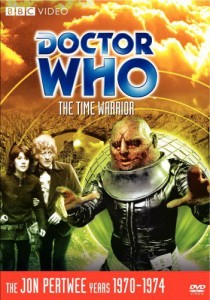 Welcome to the forty-fourth instalment of Who Review, my ongoing quest to review all available episodes of TV’s longest running SF series, Doctor Who. This week, we see the introduction of a new recurring villain and the arrival of the Doctor’s most popular companion in The Time Warrior.
Welcome to the forty-fourth instalment of Who Review, my ongoing quest to review all available episodes of TV’s longest running SF series, Doctor Who. This week, we see the introduction of a new recurring villain and the arrival of the Doctor’s most popular companion in The Time Warrior.
EPISODES
The Time Warrior
BROADCAST DATES
15 December 1973–5 January 1974 (4 Episodes)
THE DOCTOR
Jon Pertwee
THE COMPANIONS
Sarah-Jane Smith
THE EPISODES
In England in the Middle Ages, the bandit Irongron and his band of criminals discover the crashed spaceship of a Sontaran warrior known as Lynx. Lynx emerges from the ship and claims Earth in the name of the Sontaran Empire. Needing to repair his vessel, he offers Irongron “magic weapons” that will make him a king in return for aid and shelter. Though suspicious, Irongron agrees.
Using an Osmic Projector – a device that enables him to travel through time for brief periods – Lynx hypnotises and kidnaps scientists from a top secret scientific research facility in modern-day England and brings them back to the Middle Ages, where he puts them to work repairing his space ship.
The disappearances in the present draw the attention of The Doctor and Brigadier Lethbridge-Stewart, who are sent to the top secret facility to investigate. There, the Doctor meets eccentric scientist Professor Rubeish and Sarah-Jane Smith, a young reporter who has infiltrated the facility by posing as her own aunt. When Rubeish is kidnapped, The Doctor uses data he gathers to travel back to the Middle Ages in the TARDIS. Little does he realise that he has an unwanted stowaway in Sarah-Jane. Arriving in the Middle Ages, he explores Irongron’s castle. Sarah-Jane follows but is discovered by Irongron’s men and captured.
Irongron and his men have occupied a castle owned by an absent nobleman and is now posing a threat to the neighbouring kingdoms. He has provoked Lord Edward of Wessex to build an alliance against him. However, the Lord’s attempts are slow in developing, so he sends his finest archer Hal on a mission to assassinate Irongron. Unfortunately, Hal fails and is captured.
Both Sarah-Jane and Hal are brought before Irongron and Linx. The Sontaran presents his ally with a robot knight who is put to the test against the captured Hal. The archer is almost killed before the Doctor intervenes from afar, shooting the knight’s control box from Irongron’s hand.
In the ensuing chaos, Sarah-Jane and Hal escape, making their way back to Wessex Castle. There, Sarah concocts a plan to kidnap the Doctor, who she believes is in league with Irongron.
Meanwhile, the Doctor discovers Linx’s lab, where he finds the missing scientists. Unfortunately, he is captured by the Sontarian and imprisoned. He is freed by Professor Rubeish, the only scientist who hasn’t succumbed to Linx’s brainwashing. The Doctor escapes the castle but is pursued by Irongren’s men, who almost kill him. He is saved by Hal the archer.
Taken back to Wessex Castle, the Doctor manages to convince Sarah-Jane and Lord Edward that he is not allied with Linx. When Irongron and his men attack Castle Wessex the next morning, the Doctor is able to use his technical knowledge and cunning to fend off the invaders.
The Doctor then plans a counter-attack on Irongron’s castle. Disguised as friars, he and Sarah-Jane infiltrate the castle and make contact with Rubeish. Unfortunately, Linx captures him again. The Doctor offers to help the Sontaran if he agrees to return the scientists to the present, but Linx refuses and attacks the Doctor.
To save the Doctor’s life, Professor Rubeish lashes out at the villain. By chance, he strikes Linx’s probic vent, a refuelling point at the base of a Sontaran’s neck that is also their weak spot. The villain is immobilised and the Doctor uses the Osmic Projector to transport the scientists back to the 20th century.
Meanwhile, Sarah-Jane finds her way to the castle kitchen, where she drugs Irongron’s food, rendering him and his men unconscious.
Recovering from his temporary paralysis, Linx attempts to escape in his now-repaired space ship. The doctor confronts him and a battle ensues. The battle is interrupted by a drugged and half-crazed Irongron, who accuses Linx of betraying him. The Sontaran responds by killing the bandit.
Linx escapes into his space ship but is shot in the probic vent by Hal. As he dies, he triggers the launch mechanism of his space ship. As the vessel takes off, it causes an explosion that destroys the castle. Fortunately, The Doctor, his allies and Irongren’s men manage to escape, and the Doctor and Sarah-Jane depart in the TARDIS.
MY THOUGHTS
The Time Warrior is an entertaining story that harkens back to the early days of Who, when historical storylines were the norm. Unlike those past stories, it isn’t looking to educate the viewer about a specific event or moment in time, so it is in no way beholden to the facts of the era. This is both a positive and negative for the story. It seeks merely to entertain, a goal it certainly achieves. However, it’s depiction of the time period is fairly limited and one-dimensional, not really allowing for total immersion in the era in question.
Similarly, outside of Linx, the villains of the piece are fairly one dimensional and simple. Irongron is especially uninspiring. Fortunately, the supporting cast helps compensate for this flaw. Both Professor Rubeish and Hal provide some much-needed characterisation.
Astute SF fans will note that Hal is portrayed by Jeremy Bulloch, who would go onto greater SF fame as Boba Fett in Episodes Five and Six of Star Wars.
Script writer Robert Holmes makes the most of the limited castle location, which was something of a challenge imposed on him by script editor Terrence Dicks. A few years later, when Holmes was script editor, he would return the favour by having Dicks write a story set in a lighthouse (The Horror of Fang Rock).
In a humorous side note, the original outline for the serial was submitted to the production office in the form of a “Field report from Sontaran Field Marsha Hol Mes to Terran Cedicks.”
While not an instant classic, The Time Warrior is an entertaining time travel story that introduces several key elements to the Who mythos.
THE DOCTOR
The Time Warrior offers some small but significant insights onto the Doctor and, more importantly, the Time Lords. We learn that, when a Time Lord reaches the age of 200, he is considered “young no more”. It’s a subtle comment offering a glimpse into the culture of a race that lives for a thousand years or more and continually regenerates.
More importantly, we finally learn the name of the Doctor’s home planet – Gallifrey. While we’ve seen the planet itself a few times since the Time Lords were first introduced in The War Games, it was never named.
The Doctor is still saddened by the departure of Jo Grant, something that is apparent in Jon Pertwee’s performance. While still as strong and charismatic a Doctor as ever, his heart doesn’t really seem in it anymore.
THE COMPANIONS
The Time Warrior introduces Sarah-Jane Smith, possibly the most popular and well-regarded companions from the original run of Doctor Who. So far, I’m not really seeing what the overall appeal of the character is. She’s certainly strong-willed, independent and capable, but she’s lacking in depth of character. There are elements to the character that are appealing, but hopefully we’ll see more emotional range as her time in the series progresses.
According to Elisabeth Sladen, she was given very little direction on how to portray Sarah-Jane. Working her way through the script, she wrote notes on character traits she saw in Sarah, most notably “righteous indignation”, which formed the basis of her portrayal of the character. Unfortunately, “righteous indignation” seems to be all there is to Sarah in this first storyline.
Like Katy Manning before her, Elizabeth Sladen was the last actor who auditioned for the role and was not originally on producer Barry Letts shortlist.
THE VILLAINS
The Time Warrior introduces The Sontarans, arguably the most significant new villains to be added since the arrival of The Master. As an introductory storyline highlighting the nature, abilities and cultural traits of a villainous race, it is one of the strongest to date.
Linx is a genuinely intimidating villain, utilising a vast scientific and technological knowledge that in some ways equals the Doctor’s. His use of that technology is impressive, showcasing not only his skill but his cunning and deceptiveness. He presents a strong contrast to the Doctor, highlighting how similar technologies can be misused by those with less than benevolent tendencies.
Actor Kevin Lindsay revels in the role of military dictator and villain. His performance is the highlight of The Time Warrior and one that would see him return to the role of a Sontaran in the race’s next appearance in the series.
FINAL THOUGHTS
Notable for an excellent performance by Kevin Lindsay as Linx and the introduction of Sarah-Jane Smith, The Time Warrior is entertaining without being ground-breaking.
3 Lukes
NEXT
Next week I present a very special edition of Who Review as I look at the two recently rediscovered storylines from the Patrick Troughton era – Enemy of the World and The Web of Fear.








